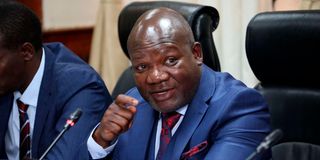
Chairman of the Council of Governors (CoG) Finance and Economic Planning Committee Fernandes Barasa, who is also the Kakamega.
A major standoff is brewing after governors rejected the proposed revenue sharing formula for 2025-26, warning that the latest method would deprive at least 21 counties of more than Sh12 billion.
Chairman of the Council of Governors (CoG) Finance and Economic Planning Committee Fernandes Barasa on Wednesday told the Nation that the proposal by the Commission on Revenue Allocation (CRA) would adversely affect the 21 counties.
"The Senate must reject the fourth formula. You cannot introduce a formula that will make 21 counties lose money and then introduce a Sh12 billion stabilisation fund. Who is going to fund this Sh12 billion?" Mr Barasa asked.
Mr Barasa, who is also the Kakamega governor, said Mandera County stands to lose the most under the new plan (Sh2.156 billion) while Kakamega will lose Sh1.345 billion, Kilifi Sh1.256 billion and Turkana Sh1.195 billion.
Others are Kwale (Sh926 million), Kisii (Sh788 million), Nakuru (Sh720 million), Nairobi (Sh667 million), Nyeri (Sh502 million), Mombasa (Sh463 million), Narok (Sh357 million), Makueni (Sh319 million), Kisumu (Sh266 million), Nandi (Sh265 million), Nyandarua (Sh202 million) and Kitui (Sh200 million).
Homa Bay, Uasin Gishu, Kirinyaga, Trans Nzoia and Machakos counties will lose Sh174 million, Sh160 million, Sh74 million, Sh35 million and Sh32 million, respectively.
"This is a matter that was discussed at the Intergovernmental Budget and Economic Council (IBEC) on Monday and I put my foot down and I'm on record that we reject this formula," Barasa said.
"We are asking all senators who believe in devolution to reject this fourth formula proposed by the CRA because it is not equitable, it is not fair.”
Last December, the CRA submitted a recommendation to the Senate, National Assembly, National Executive, County Assemblies and County Executives on the fourth formula for revenue sharing among county governments.
The Mary Chebukati-led commission set the minimum base at Sh417.4 billion to be used from the 2025-2026 financial year, up from the current Sh387 billion for the 2024-2025 financial year.
In the new formula, the CRA said it took into account population (42 percent), equity (22 percent), geographical size (nine percent), poverty (14 percent) while income gap will be fixed at 13 percent— to be used in the next five financial years.
The commission argued that in determining the fourth revenue-sharing base, it took into account information on the review of the previous revenue-sharing bases, views of stakeholders, international best practices and the criteria in Article 203(1).
But on Wednesday, Mr Barasa said they'd rather stick with the current third formula than rush to the fourth, which would disenfranchise several countries.
"In countries like South Africa, we have had formulas in place for 30 years. There is nothing illegal about counties not using the third formula of revenue sharing," said Mr Barasa.
He said he had the support of the governors of the 21 counties that would be affected if the new formula is applied.
"They support me and we are calling on our senators to stand up and be counted when this formula is presented in the Senate. We cannot sit back and watch a few counties take advantage of a formula that will disadvantage 21 counties," Mr Barasa added.
The Constitution provides that in making a recommendation on the equitable sharing of revenue among county governments, the Commission shall have regard to the need to ensure that county governments are able to perform the functions assigned to them and to the fiscal capacity and efficiency of county governments.
The commission is also required to take into account the developmental and other needs of counties, economic disparities within and between counties and the need to address them.
The CRA is also expected to adhere to the need for affirmative action in respect of disadvantaged areas and groups, the need for economic optimisation of each county and to provide incentives for each county to optimise its capacity to raise revenue, and the desirability of stable and predictable revenue allocations.
Mrs Chebukati, the chairperson of the CRA, said at a press briefing in December last year that in developing the framework for the fourth base, the commission had moved from the functional approach of the third base to the use of expenditure proxies.
According to the CRA, the shift was informed by the actual expenditure of county governments, the availability, credibility and statistical soundness of data, and the need to ensure that revenue sharing among county governments remains stable and predictable over the medium term.
"The county government revenue sharing framework is based on two objectives of equitable revenue sharing: to facilitate service delivery and to address economic disparities and promote development among county governments," said Mrs Chebukati.
The Commission argues that to facilitate service delivery, the proposal provides for an equal minimum allocation to all counties, using a county's population and geographical size as the key transfer parameters.
And to address economic disparities and promote development, the framework uses income distance and poverty parameters as measures of inequality between county governments.
"The weights assigned to each of the parameters in the revenue sharing framework are based on the objectives of fiscal transfers and the desire to ensure that revenue sharing remains stable and predictable," she argued.
She further explained that in implementing the fourth base, a cushion and stabilisation factor has been built into the framework to ensure that no county government receives less than its allocation in the 2024/25 financial year, but Mr Barasa insists that there is no guarantee that this fund will be made available.
Stability in revenue sharing is important to ensure that county programmes and projects continue without disruption caused by sudden budget cuts due to changes in the revenue sharing framework.
Section 217 of the Constitution requires the Senate to determine, by resolution, the basis for revenue sharing among county governments every five years.
In doing so, the Senate must take into account the recommendation of the Commission.
The current basis is the Third Basis, which was set by Parliament in September 2020.
This basis has been used for revenue sharing for five financial years from the 2020/21 financial year to the current 2024/25 financial year.
The Fourth Basis for revenue sharing among county governments, which is opposed by the 21 counties, should be set by Parliament for sharing among county governments from the 2025/26 financial year onwards.
What counties stand to lose
1. Mandera 2.156 billion
2. Kakamega 1.345 billion
3. Kilifi 1.256 billion
4. Turkana 1.195 billion
5. Kwale 926 million
6. Kisii 788 million
7. Nakuru 720 million
8. Nairobi 667 million
9. Nyeri 502 million
10. Mombasa 463 million
11. Narok 357 million
12. Makueni 319 million
13. Kisumu 266 million
14. Nandi 265 million
15. Nyandarua 202 million
16. Kitui 200 million
17. Homa Bay 174 million
18. Uasin Gishu 160 million
19. Kirinyaga 74 million
20. Trans Nzoia 35 million
21. Machakos 32 million










